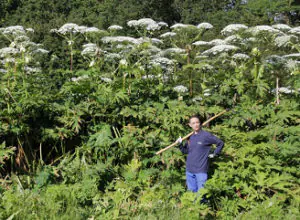With the arrival of summer, patients who have been poisoned, and more often, burnt by hogweed, often turn to doctors. The plant attracts attention with its tall growth and huge umbrella of seeds, but an attempt to take a photo nearby or pick a leaf ends in painful burns. If ingested, the juice can lead to irreversible changes in the esophagus and stomach. It is important to quickly provide first aid to the victim.
The content of the articleWhat does hogweed look like?
The grass Hogweed belongs to the family of umbrella plants. There are biennial and perennial varieties of this herb. An adult bush amazes with its gigantic size: it reaches 2.3-3 meters in height. Within the city limits and in the first year of growth, specimens of 40-60 centimeters are more common. They camouflage themselves among useful agricultural crops, found in wheat and sunflower crops.
When describing what hogweed looks like, it is worth mentioning the huge carved leaves of a lush green color and massive stems that resemble hollow tubes. When flowering, umbrellas with many white or pink flowers are formed, which attract insects with a subtle pleasant smell. When uprooted, you can see a dense root reaching a length of 1.5-2 meters. After ripening, small seeds are carried by the wind over long distances, so the weed actively invades new territories and easily penetrates well-kept gardens.
In the post-war period, domestic agronomists tried to cultivate the plant on an industrial scale, using it to feed livestock. They relied on the experience of North American farmers who used one type of dangerous weed to make silage. But when this plant was added to the feed of cows and goats, milk with a specific taste was obtained, and the bitterness was not removed during heat treatment. The idea was abandoned, but hogweed still grows in many fields, posing a danger to people.
Common types of hogweed
In nature, there are at least 70 species of this representative of the umbrella family. Among them are not only poisonous plants, but also decorative varieties, bred through long-term selection for decorating areas and arranging bouquets. In the middle zone and temperate climates you can encounter the following varieties:
- Tip: Baking soda paste helps neutralize the effect of coumarin.
If pollen gets into your eyes, rinse with cool water, which will reduce the burning sensation. A clean napkin soaked in strong tea leaves is placed on the affected eye, and the antiseptic Albucid (Sodium Sulfacyl) is instilled.
Features of treatment of burns from hogweed
Upon admission to the hospital, the victim is administered antihistamines intramuscularly. They reduce the risk of developing angioedema and other types of allergies, relieve itching and burning of the skin, and eliminate laryngeal spasms. It is necessary to normalize the pressure and temperature, treat the affected areas with antiseptics (Chlorhexidine, Miramistin). Similar measures are carried out in case of poisoning by pesticides.
Important! After contact with hogweed, you should definitely consult a doctor. Sometimes an allergic reaction develops only after 10-12 hours, causing dangerous suffocation. When you receive a burn on 70-80% of the body surface, the risk of death increases significantly.To cure a burn from hogweed, take the following measures:
- For 5-10 days, the patient should take antiallergic drugs: Claritin, Zodak, Suprastin.
- On the first day, the cleansing of the body from toxins is accelerated with the help of enterosorbents (Atoxil, Enterosgel, Polyphepan, etc.).
- A bandage is applied to the wounds with ointment for burns: Bepanten, Solcoseryl, Levomekol.
- For severe pain, anti-inflammatory and painkillers are prescribed: Nurofen, Ibuprofen.
For 2 days after the juice gets on the skin, you should not go out into the sun, so as not to worsen the condition of the epidermis. Recovery depends on the health and age of the victim. Full recovery often takes 4-6 weeks.
Treating hogweed burns with folk remedies helps speed up healing:



